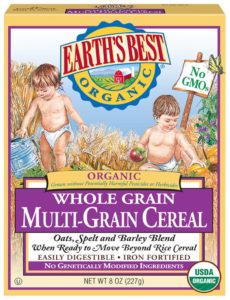Off to a Good Start with Baby Cereal

By Reed Mangels, PhD, RD
For the first 6 months or so after birth, babies don’t need any food other than breast milk (ideally) or a commercial infant formula or a combination of breast milk and infant formula. But, around age 6 months, most babies are showing the signs of being ready to start eating solid foods. They can sit independently which gives them the ability to lean forward if they want food or to move back if they don’t. They are showing an interest in what others are eating. They can move food from the front to the back of the mouth, where it can be swallowed more easily.
An often-recommended first food is a single ingredient baby cereal, meaning it only contains one cereal grain. Since it has only one ingredient, it’s easy to know what the baby is reacting to if the baby has a reaction. It can be thinned with breast milk or formula to a good consistency – first a thin consistency, with a gradual increase in thickness. If it is made with breast milk or the baby’s formula, it will have a taste the baby is familiar with. Many baby cereals are fortified with iron and some also have added zinc and vitamin B12. Once the baby tolerates single ingredient cereals, cereals with several grains can be introduced.
You may have heard about concerns about the arsenic levels in baby rice cereal. Arsenic can be harmful to the baby’s brain (1). Once these elevated levels of arsenic were discovered, baby food companies worked to reduce the amount of arsenic in their products. The FDA has recently reported that 76% of samples of baby rice cereals did not contain excess arsenic, compared to 47% of samples tested in 2014 and 36% of samples tested between 2011-2013. (2). Other infant cereals, including those made with oats, barley, and multi-grains, are lower in arsenic; use of a variety of cereals is recommended.
Some parents and caregivers may prefer to make baby cereals. Uncooked oats, barley, or rice can be processed in a blender until finely ground and then cooked until smooth. These cereals don’t have the iron that is usually added to commercial baby cereals. If parents or caregivers make their own baby cereals, use of an iron supplement should be discussed with the baby’s doctor.
Baby cereals can be fed from a spoon and should not be fed from a bottle. If your little one likes to self-feed, make the baby cereal fairly thick, chill it, and cut it into small bites. It can also be spread onto small pieces of toast.
Here’s a nutritional comparison of several brands of organic baby cereals that are fortified with iron.
| Product Serving Size | Iron (mg) | Zinc (mg) | Vitamin B12 (mcg) | Comments |
| Beech-Nut Oatmeal, 1/4 cup dry | 6.8 | 0.8 | 0.13 | Has added B- vitamins and calcium. Contains vitamin D3 apparently from a non-vegan source. |
| Gerber Rice, 1/4 cup dry | 6.75 | 1 | 0.125 | Has added calcium, vitamin C and B- vitamins |
| Gerber Oatmeal, 1/4 cup dry | 6.75 | 1 | 0.125 | Has added calcium, vitamin C and B- vitamins |
| Gerber Oatmeal- Millet- Quinoa, 1/4 cup dry | 6.75 | 1 | 0.125 | Has added calcium, vitamin C and B- vitamins |
| Earth’s Best Rice, 1/4 cup dry | 6.3 | — | — | |
| Earth’s Best Oatmeal, 1/4 cup dry | 6.3 | — | — | |
| Earth’s Best Multi- Grain, 1/4 cup dry | 6.3 | — | — | |
| Happy Baby Oatmeal, 3 TB dry | 5 | — | — | |
| Happy Baby Oats & Quinoa, 3 TB dry | 5 | — | — |
Nutritional information from manufacturers’ websites and package labels, October, 2020.
References
1. European Food Safety Authority Panel on Contaminants in the Food Chain. Scientific opinion on arsenic in food: EFSA panel on contaminants in the food chain (CONTAM). Eur Food Safe Auth J. 2009;7(10):1-199.
2. U.S. Food and Drug Administration. FDA Issues Final Guidance for Industry on Action Level for Inorganic Arsenic in Infant Rice Cereals. https://www.fda.gov/food/cfsan-constituent-updates/fda-issues-final-guidance-industry-action-level-inorganic-arsenic-infant-rice-cereals Published August 5, 2020.
